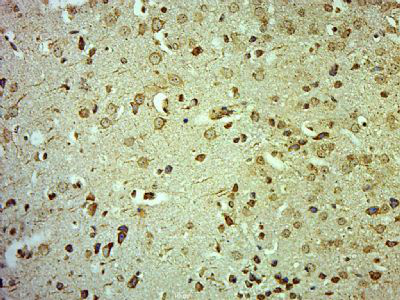产品货号 : mlR6981
英文名称 : CLCN3
中文名称 : 氯离子通道蛋白3抗体
别 名 : Chloride channel 3; Chloride channel protein 3; Chloride transporter ClC 3; Chloride transporter ClC-3; Chloride transporter ClC3; ClC 3; ClC-3; ClC3; CLCN 3; CLCN3; CLCN3_HUMAN; H(+)/Cl(-) exchange transporter 3.
研究领域 : 细胞生物 神经生物学 信号转导 通道蛋白
抗体来源 : Rabbit
克隆类型 : Polyclonal
交叉反应 : Human, Mouse, Rat, Chicken, Dog, Pig, Cow, Horse,
产品应用 : WB=1:500-2000 ELISA=1:500-1000 IHC-P=1:400-800 IHC-F=1:400-800 IF=1:50-200 (石蜡切片需做抗原修复)
not yet tested in other applications.
optimal dilutions/concentrations should be determined by the end user.
分 子 量 : 91kDa
细胞定位 : 细胞浆 细胞膜
性 状 : Lyophilized or Liquid
浓 度 : 1mg/ml
免 疫 原 : KLH conjugated synthetic peptide derived from human CLCN3/CLC-3:81-180/818
亚 型 : IgG
纯化方法 : affinity purified by Protein A
储 存 液 : 0.01M TBS(pH7.4) with 1% BSA, 0.03% Proclin300 and 50% Glycerol.
保存条件 : Store at -20 °C for one year. Avoid repeated freeze/thaw cycles. The lyophilized antibody is stable at room temperature for at least one month and for greater than a year when kept at -20°C. When reconstituted in sterile pH 7.4 0.01M PBS or diluent of antibody the antibody is stable for at least two weeks at 2-4 °C.
PubMed : PubMed
产品介绍 : Mediates the exchange of chloride ions against protons. Functions as antiporter and contributes to the acidification of the endosome and synaptic vesicle lumen, and may thereby affect vesicle trafficking and exocytosis. May play an important role in neuronal cell function through regulation of membrane excitability by protein kinase C. It could help neuronal cells to establish short-term memory.
Function:
Mediates the exchange of chloride ions against protons. Functions as antiporter and contributes to the acidification of the endosome and synaptic vesicle lumen, and may thereby affect vesicle trafficking and exocytosis. May play an important role in neuronal cell function through regulation of membrane excitability by protein kinase C. It could help neuronal cells to establish short-term memory.
Subunit:
Homo- or heterodimer. Isoform 2 interacts with GOPC, PDZK1 and SLC9A3R1/EBP50.
Subcellular Location:
Isoform 1: Membrane; Multi-pass membrane protein. Early endosome membrane; Multi-pass membrane protein. Late endosome membrane; Multi-pass membrane protein. Cytoplasmic vesicle, secretory vesicle membrane; Multi-pass membrane protein. Isoform 2: Membrane; Multi-pass membrane protein. Early endosome membrane; Multi-pass membrane protein. Late endosome membrane; Multi-pass membrane protein. Golgi apparatus membrane; Multi-pass membrane protein.
Tissue Specificity:
Expressed primarily in tissues derived from neuroectoderm. Within the brain, its expression is particularly evident in the hippocampus, olfactory cortex, and olfactory bulb. Highly expressed in aortic and coronary vascular smooth muscle cells, and aortic endothelial cells. Also expressed in tracheal and alveolar epithelial cells, and intima and media of the pulmonary vessels. Expressed in bronchus and colon (at protein level).
Post-translational modifications:
N-glycosylated.
Similarity:
Belongs to the chloride channel (TC 2.A.49) family. ClC-3/CLCN3 subfamily.
Contains 2 CBS domains.
SWISS:
P51790
Gene ID:
1182
Important Note:
This product as supplied is intended for research use only, not for use in human, therapeutic or diagnostic applications.
产品图片












